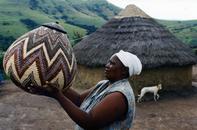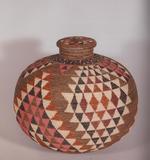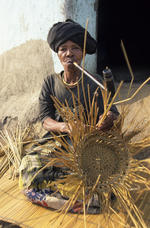Female involvement in basket industries became increasingly common following the breakdown of the apartheid state’s influx control regulations in the late 1980s. While some rural women flocked to the cities to join their husbands, sometimes finding work in cottage industries serving South Africa’s burgeoning tourist market, others remained in rural areas, producing baskets for sale to this growing clientele.

The commercialisation of basket weaving traditions in northern KwaZulu-Natal was spearheaded by Kjell and Bertha Löfroth, who moved from Sweden to South Africa in 1951, working for five years at the Ceza Mission Station in northern KwaZulu-Natal before becoming involved in the Evangelical Lutheran Church Art and Craft Centre at Rorke's Drift in the mid-1960s.
The Löfroths are best remembered for their role in establishing the Vukani Association in Eshowe, where they worked to support efforts by the South African Council of Churches to promote international sanctions and disinvestments against the apartheid state while introducing craft and other programmes at home aimed at assisting the rural and urban poor.
Although in Zulu-speaking communities basket weaving was originally associated with men, women became the main producers of baskets intended for commercial distribution.

Because of its historic links to present-day KwaZulu-Natal, the Evangelical Lutheran Mission played a critical role in implementing the South African Council of Church’s anti-apartheid policy among rural Zulu-speaking communities.
As part of these efforts, the Swedish missionaries, Kjell and Bertha Löfroth, who founded the Vukani Association in Eshowe, tried to support starving families in the wake of a severe drought that crippled rural communities in northern KwaZulu in 1966 and 1967.
After attempts to distribute food to needy households had to be abandoned when funds for this purpose dried up, the Löfroths undertook, instead, to assist producers to market the skills they normally employed to make household items for themselves, ultimately contributing to the development of new basket styles for sale to commercial outlets.
Several weavers who initially benefited from this scheme became highly acclaimed, marketing beautifully crafted baskets to both local and international collectors.

Since very few tools are required to weave baskets, making artefacts from grass is readily accessible to outlying rural communities lacking access to urban centres as well as the means to purchase the equipment needed to make other household items such as carved vessels.
Female weavers, who are responsible for a host of task in and around their homesteads, generally value the flexibility afforded by producing baskets that can be worked on in a variety of settings, for example, under the shades of trees; or while attending to other activities, such as cooking and breastfeeding; or when guarding maturing grain fields from birds; and especially when socialising with other members of their community.
By Professor Sandra Klopper